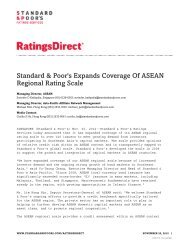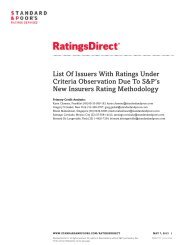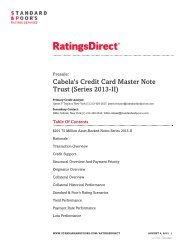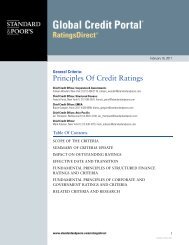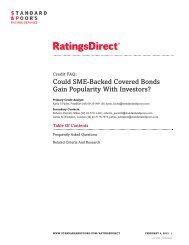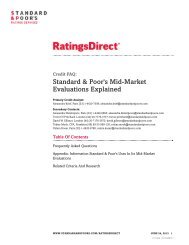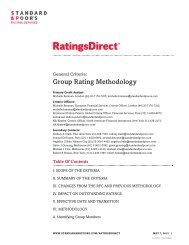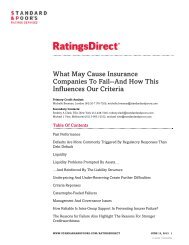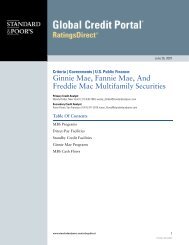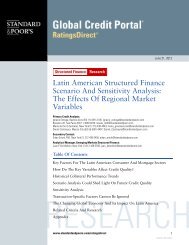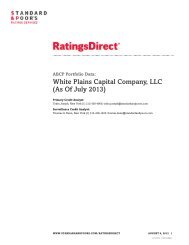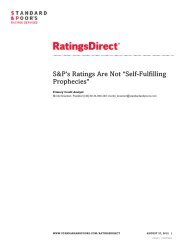Criteria for Rating German Residential Mortgage ... - Standard & Poor's
Criteria for Rating German Residential Mortgage ... - Standard & Poor's
Criteria for Rating German Residential Mortgage ... - Standard & Poor's
You also want an ePaper? Increase the reach of your titles
YUMPU automatically turns print PDFs into web optimized ePapers that Google loves.
Table 3<br />
<strong>Criteria</strong> Structured Finance RMBS: <strong>Criteria</strong> <strong>for</strong> <strong>Rating</strong> <strong>German</strong> <strong>Residential</strong> <strong>Mortgage</strong>-Backed Securities<br />
Characteristics Affecting Base Foreclosure Frequency and Related Adjustment Guidelines<br />
Description of characteristic Foreclosure frequency adjustment guidelines<br />
Loan-to-value (LTV) < 55% Base multiplied by 0.8<br />
LTV 55% to 80% Base multiplied by 1.0 (no change)<br />
LTV > 80% Base multiplied by 1.1 to 3.0 according to a continuous function.<br />
Indicative multiples at discrete LTV levels are given as follows:<br />
85% LTV = base multiplied by 1.2<br />
90% LTV = base multiplied by 1.6<br />
95% LTV = base multiplied by 2.4<br />
100% LTV = base multiplied by 3.0<br />
Interest-only loans (endfaellige Darlehen) without satisfactory<br />
additional collateral (term < 20 years)<br />
Base multiplied by 1.67<br />
Letting loans (fremdvermietete Objekte) Base multiplied by 1.5 to 1.8 and then added to base (e.g., <strong>for</strong> a base of 12%: base<br />
multiplied by 1.67 = 20%; base plus 20% = 32%<br />
Loan size > €400,000 or equivalent Increases by 1% to 20% of base (increases as loan size increases and caps when<br />
loan size reaches €1,000,000)<br />
Unacceptable geographic concentration Case-by-case consideration<br />
Af<strong>for</strong>dability not adequately assessed Case-by-case consideration<br />
Completion date >18 months (with no arrears) Subtract 10% to 25% of base (increases as seasoning increases and caps when<br />
seasoning reaches about 60 months)<br />
Arrears Case-by-case consideration, based on arrears management and per<strong>for</strong>mance data<br />
Loan-to-Value (LTV)<br />
LTV is defined as the ratio of aggregate mortgage debt divided by the value of the property. This ratio has<br />
historically been a key <strong>for</strong>eclosure predictor, with low LTV ratios associated with lesser probabilities of loan default.<br />
A low LTV ratio indicates that a borrower has a high equity investment in a property, but can also indicate some<br />
prior financial management.<br />
<strong>Standard</strong> & <strong>Poor's</strong> ability to rely on LTV ratios is crucial, given that the LTV ratio is important in the estimation of<br />
<strong>for</strong>eclosure frequency (and loss severity, see below). In general, securitized loans in <strong>German</strong>y have benefited from<br />
full property valuations. <strong>German</strong> mortgage lending banks typically have in-house valuation experts, with extensive<br />
experience in the building and construction industry.<br />
<strong>German</strong> banks normally use a material value method (Sachwertverfahren) or a return value method<br />
(Ertragswertverfahren) to determine the value of a property. The resulting market valuation is then deducted by a<br />
certain percentage to give a "lendable" value or Beleihungswert. Lenders use this reduction as potential coverage in<br />
a <strong>for</strong>ced sale situation. Typically, the less liquid the property is considered to be, the higher the deducted percentage<br />
(or haircut) is from the property value. This approach stems from <strong>Mortgage</strong> Banking Act requirements <strong>for</strong> those<br />
banks regulated by this act, but has also been adopted by nonmortgage banks.<br />
In order to give benefit to this conservative valuation haircut, <strong>Standard</strong> & <strong>Poor's</strong> adjusts the lendable values in its<br />
calculation of LTV ratios. Subsequent references to LTV in this article refer to this adjusted LTV. The degree of<br />
uplift to the valuation depends on the transaction structure. In synthetic structures, where a minimum level of<br />
haircut is stated in the eligibility criteria, and where all losses are audited prior to being allocated, <strong>Standard</strong> &<br />
<strong>Poor's</strong> will typically re-engineer the valuation, giving full benefit to the haircut. The timing and comprehensiveness<br />
of the audit will affect this analysis. In the case of true sale transactions, partial benefit is given, resulting in a<br />
valuation that is below market value but in excess of the Beleihungswert.<br />
<strong>Standard</strong> & Poors | <strong>Rating</strong>sDirect on the Global Credit Portal | August 31, 2001 6<br />
867630 | 300323561




